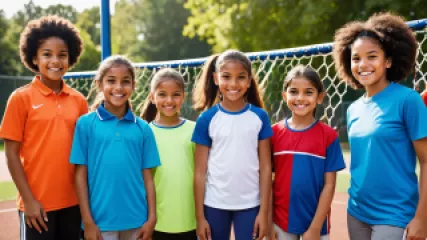Why Improving Resilience in Children is More Crucial Than Ever
In today's fast-paced world, the significance of childhood resilience cannot be overstated. As we navigate through unprecedented challenges—from global pandemics to economic uncertainties—resilience has emerged as a critical skill that children must develop to thrive. I firmly believe that enhancing childhood resilience is more crucial now than ever before. In this opinion piece, I will delve into why this is the case, explore various ways to build resilience in childhood, and discuss the broader implications for society.
The Changing Landscape of Childhood
As someone who has spent years observing the evolving landscape of childhood, it's apparent that today's children face unique challenges that were unheard of just a few decades ago. The rapid advancement of technology, coupled with societal changes, has created an environment where children are exposed to stressors earlier and more frequently than previous generations.
"Childhood today is vastly different from what it was even two decades ago. The pressures and expectations placed on children have changed, making resilience a necessary skill." Dr. Emily Haines, Child Psychologist
From cyberbullying to academic pressures, the need for resilience training for children has never been more pressing. Children are now required to navigate complex social landscapes both online and offline, making it imperative that they develop robust coping mechanisms.
The Impact of Technology
One of the most significant changes in the lives of children today is the omnipresence of technology. While technology offers numerous benefits, it also brings about challenges that can affect a child's well-being. Social media, for example, has become a double-edged sword. On one hand, it provides a platform for connection and learning; on the other hand, it exposes children to cyberbullying and unrealistic standards of beauty and success.
- Cyberbullying: Unlike traditional bullying, cyberbullying can follow a child home, making it relentless and pervasive.
- Screen Time: Excessive screen time has been linked to increased anxiety and decreased physical activity, both of which can undermine resilience.
- Unrealistic Expectations: Social media often portrays idealized versions of life, leading children to compare themselves unfavorably and feel inadequate.
Given these challenges, improving resilience in children becomes vital. Resilient children are better equipped to handle the pressures of social media and technology, making them less susceptible to its negative effects.
Resilience Training: A Necessity, Not a Luxury
Resilience training for children is not just a luxury; it is a necessity. Building resilience helps children manage stress, adapt to change, and recover from setbacks. It equips them with the skills needed to navigate the complexities of modern life.
According to the American Psychological Association, resilience is not an innate trait but rather a set of behaviors, thoughts, and actions that can be learned and developed. This means that with the right guidance and support, every child has the potential to become resilient.
Why Resilience Matters More Than Ever
The importance of resilience in childhood is underscored by the current global climate. The COVID-19 pandemic, for instance, has disrupted the lives of millions of children worldwide. School closures, social isolation, and the uncertainty surrounding the future have all contributed to heightened levels of stress and anxiety among children.
"The pandemic has highlighted the need for resilience in children. Those who are resilient are better able to cope with the disruptions and uncertainties brought about by such unprecedented events." Dr. Michael Levine, Pediatrician
In addition to the pandemic, other factors such as economic instability and environmental concerns further emphasize the need for resilience. Children today are growing up in a world where change is the only constant, and resilience is their best tool for navigating this ever-changing landscape.
Ways to Build Resilience in Childhood
Now that we understand the importance of resilience, the next step is to explore effective ways to build it in children. Here are some strategies that can help:
- Foster Strong Relationships: Building strong, supportive relationships with family, friends, and mentors is crucial for developing resilience. These relationships provide a sense of security and belonging, which are essential for emotional well-being.
- Encourage Problem-Solving Skills: Teaching children how to solve problems independently helps them build confidence in their abilities. Encourage them to think critically and come up with solutions to challenges they face.
- Promote a Growth Mindset: A growth mindset—believing that abilities can be developed through effort and learning—helps children view challenges as opportunities for growth. Encourage them to embrace mistakes as part of the learning process.
- Teach Emotional Regulation: Helping children understand and manage their emotions is key to building resilience. Teach them coping strategies such as deep breathing, mindfulness, and positive self-talk.
- Model Resilient Behaviors: Children learn by observing the adults around them. Model resilient behaviors by demonstrating how to handle stress, setbacks, and challenges positively.
By incorporating these strategies into daily life, parents, educators, and caregivers can play a pivotal role in enhancing childhood resilience.
The Role of Schools in Building Resilience
Schools also play a critical role in building resilience in children. Educational institutions are not just places for academic learning; they are environments where children develop social skills, emotional intelligence, and coping mechanisms. Schools can implement programs and practices that foster resilience, such as:
- Social-Emotional Learning (SEL) Programs: SEL programs teach children essential skills like empathy, self-awareness, and relationship-building, all of which contribute to resilience.
- Mentorship Programs: Pairing students with mentors can provide additional support and guidance, helping them navigate challenges more effectively.
- Extracurricular Activities: Participation in sports, arts, and other extracurricular activities helps children build confidence, teamwork skills, and a sense of accomplishment.
- Safe and Inclusive Environment: Creating a safe and inclusive school environment where all students feel valued and respected is fundamental to fostering resilience.
By prioritizing these initiatives, schools can significantly contribute to improving resilience in children, setting them up for success both academically and personally.
The Long-Term Benefits of Resilience
Enhancing childhood resilience has far-reaching benefits that extend into adulthood. Resilient children are more likely to grow into well-adjusted, successful adults who can handle life's challenges with grace and perseverance. Here are some long-term benefits of resilience:
- Improved Mental Health: Resilient individuals are less likely to experience mental health issues such as anxiety and depression. They have the tools to cope with stress and bounce back from adversity.
- Better Academic and Career Outcomes: Resilience is linked to higher academic achievement and better career prospects. Resilient individuals are more likely to persevere through challenges and achieve their goals.
- Stronger Relationships: Resilient people tend to have healthier, more fulfilling relationships. They can communicate effectively, resolve conflicts, and offer support to others.
- Greater Life Satisfaction: Overall, resilience contributes to a higher quality of life. Resilient individuals are more likely to feel satisfied and fulfilled in various aspects of their lives.
The benefits of resilience underscore the importance of investing in resilience training for children. By doing so, we are not only helping them navigate the challenges of childhood but also setting the stage for a brighter, more fulfilling future.
The Broader Implications for Society
While the benefits of resilience are evident on an individual level, the broader implications for society are equally significant. A society composed of resilient individuals is better equipped to handle collective challenges and thrive in the face of adversity. Here are some ways in which enhancing childhood resilience can benefit society as a whole:
- Reduced Healthcare Costs: Resilient individuals are less likely to experience chronic stress-related illnesses, leading to reduced healthcare costs and a healthier population overall.
- Increased Productivity: Resilient individuals are more productive and better able to contribute to the workforce. This leads to economic growth and stability.
- Stronger Communities: Resilient individuals are more likely to engage in community-building activities and offer support to those in need, resulting in stronger, more cohesive communities.
- Innovation and Progress: Resilient individuals are more likely to take risks and innovate, driving progress and development in various fields.
Investing in resilience training for children is, therefore, an investment in the future of society. By fostering resilience in the next generation, we are laying the foundation for a more resilient, prosperous, and harmonious world.
The Role of Policy Makers
Policy makers also have a crucial role to play in promoting resilience in children. By implementing policies that support mental health, education, and family well-being, they can create an environment conducive to resilience building. Some policy recommendations include:
- Increased Funding for Mental Health Services: Providing adequate funding for mental health services in schools and communities ensures that children have access to the support they need.
- Support for Families: Policies that support families, such as parental leave, affordable childcare, and financial assistance, can reduce stress and create a stable environment for children.
- Inclusive Education Policies: Ensuring that schools are inclusive and provide equal opportunities for all students fosters a sense of belonging and resilience.
- Community Programs: Investing in community programs that promote social-emotional learning, mentorship, and extracurricular activities can provide additional support for children and families.
By prioritizing these policies, lawmakers can play a significant role in improving resilience in children and creating a more resilient society.
Conclusion: A Call to Action
In conclusion, the importance of improving resilience in children cannot be overstated. As we navigate an increasingly complex and uncertain world, resilience is the key to helping children thrive. From the changing landscape of childhood to the broader implications for society, the need for resilience training for children is more crucial than ever.
As parents, educators, policymakers, and community members, we all have a role to play in enhancing childhood resilience. By fostering strong relationships, encouraging problem-solving skills, promoting a growth mindset, and teaching emotional regulation, we can equip children with the tools they need to navigate life's challenges.
Moreover, schools and policymakers must prioritize initiatives that support resilience building, creating an environment where every child has the opportunity to develop this essential skill. The long-term benefits of resilience extend beyond the individual, contributing to a healthier, more productive, and more cohesive society.
"Investing in resilience training for children is an investment in the future of our society. By fostering resilience in the next generation, we are laying the foundation for a brighter, more fulfilling future for all." Van Greene
Let us commit to making resilience a cornerstone of childhood development, ensuring that our children are prepared to face whatever challenges come their way. Together, we can build a more resilient world, one child at a time.






